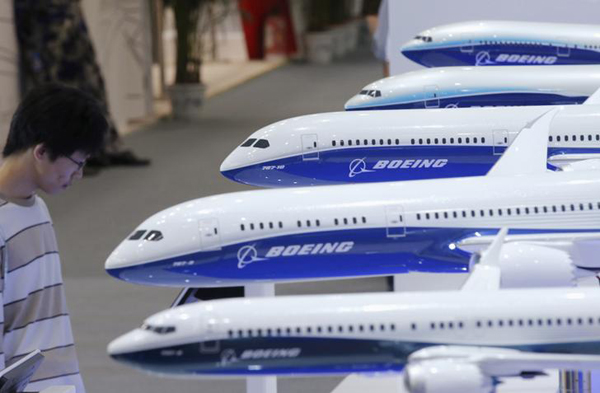 |
|
A visitor looks at a display of miniature Boeing passenger aircraft at an aviation expo in Beijing last year. Boeing forecasts Chinese carriers will account for 45 percent of the total demand for airplanes in the Asia-Pacific region in the next two decades. [Photo/Agencies] |
China will need 6,020 new aircraft valued at $870 billion in the next 20 years, as a result of its robust economic growth and the entry of more carriers, global aircraft maker Boeing Co said in a report on Thursday.
The United States-based company said in its annual China Current Market Outlook that Chinese carriers will account for 45 percent of the total demand for airplanes in the Asia-Pacific region during the forecast period. According to Boeing estimates, global demand during the same period is expected to be around 36,800 aircraft valued at about $5.2 trillion.
China and other developing markets, such as Southeast Asia, Latin America and Middle East regions, contribute the most in terms of demand for new aircraft and overall market growth, said Randy Tinseth, Boeing Commercial Airplanes vice-president of marketing.
The annual average passenger volume growth in China will be around 6.9 percent, while the average GDP growth will be 6.2 percent from 2013 to 2033, Boeing said.
"China's aviation market is going through dynamic changes," Tinseth said. New business models like low-cost carriers and airplane leasing companies will provide the growth impetus, he said.
According to Tinseth, low-cost carriers seem to be the most promising sector in terms of growth, due to government support. Though the number of low-cost airlines increased from just one to five this year, several other carriers are considering the change-over.
"The growth in low-cost carriers will stimulate air traffic and increase demand for single-aisle airplanes," Tinseth said.
New deliveries of single-aisle aircraft are expected to reach 4,340 by 2033, according to Boeing estimates. In last year's market outlook, Boeing had forecast that China will need 5,580 new aircraft, worth some $780 billion by 2032, which was slightly lower than this year's forecast.
Though Boeing remains confident on growth prospects in China, some industry experts feel that the outlook is over-optimistic as most of the Chinese carriers saw profit drop during the first six months of the year.
The net profit of Air China fell by 57.6 percent in the first half of this year, compared with the corresponding period in 2013. China Southern Airlines' net loss was 101 million yuan in the first half of 2014 while China Eastern Airlines' net profit was down by 97.76 percent during the same period.
Li Jun, an analyst with China Galaxy Securities, said that although most of the carriers attributed the profit drop to foreign exchange losses, the slower economic growth, the government's anti-corruption regulations and competition from high-speed trains have also hampered growth prospects.
Tinseth, however, said Boeing's outlook is long-term and for the next 20 years and it is normal for the global civil aviation industry to go through ups and downs. "It is a flexible market and can recover very soon," he said.
"Generally speaking, our outlook is still conservative," said Tinseth, as the real deliveries of narrow-body aircraft worldwide in the past few years were larger than the manufacturer's forecasts. The outlook for wide-body aircraft was slightly higher than actual deliveries, he said.
